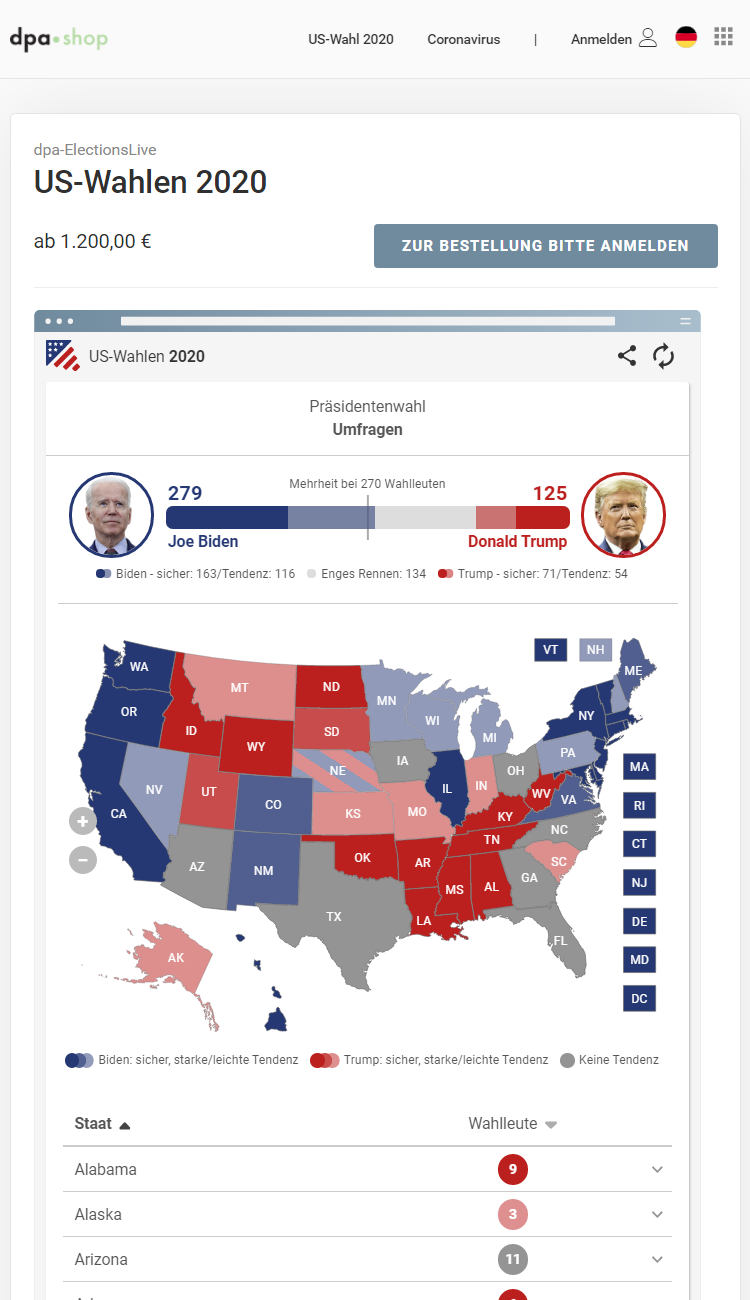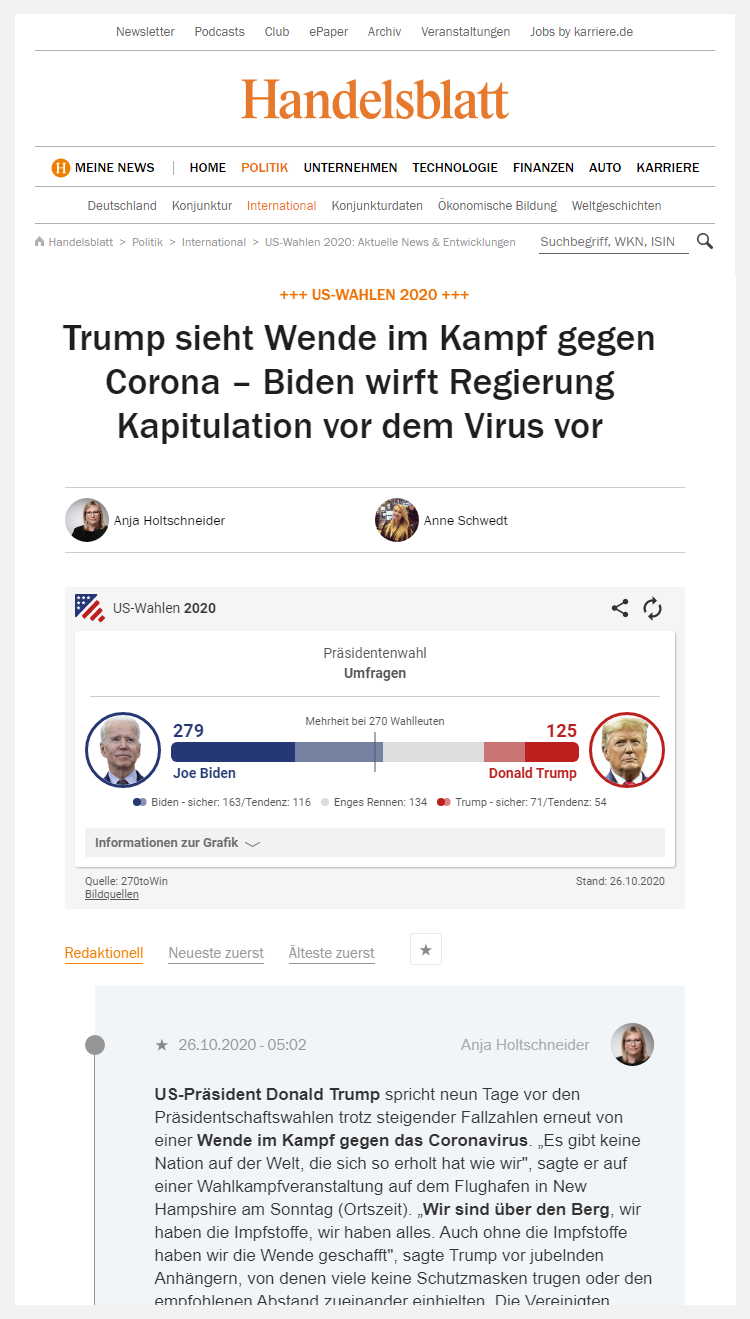by Helmy Giacoman | November 1, 2021
November 1, 2021
How to use Live Blog’s SEO features

How to use Live Blog’s SEO features
One of the key advantages of having a live blog for digital publishers is the SEO boost that real-time news coverage provides. In this post we look at the technical side of SEO in our Live Blog platform and explain how you can make the most of this in your settings and on your website.
Part 1: ESI and SEO
First, let’s take a look at what Live Blog is, and how it relates to your other content. In essence, Live Blog is a curated timeline of news updates marked with a timestamp. In technical terms it is a group of HTML elements that can be embedded into third-party websites by using an embed code, which takes care of loading that curated timeline of news into the host website.
To host their live blog, many publishers use an iFrame embed code – an HTML element that is used to insert content from a third-party source – which is the quickest way to integrate content from Live Blog into their website. For users coming to the host website, there is no visible difference between Live Blog and any other content.
Here is an example iFrame embed code:
<script src="https://test.liveblog.pro/embed.js" defer></script> <iframe id="liveblog-iframe" width="100%" scrolling="no" src="https://test.liveblog.pro/lb-test/blogs/6172fcbdab5f4af0268694e2/index.html" data-responsive="yes" frameborder="0" allowfullscreen></iframe>
For search engines, however, the iFrame element (officially called an Inline FRAME) used by default by Live Blog makes the content unreadable and, as a result, does nothing to improve the quality and quantity of your website traffic. That’s because the iFrame is like an envelope, and the Live Blog is like the letter inside. If you want the postal service (i.e. search engines) to read the letter, you have to provide them specific instructions to do so.
The way we recommend to open the envelope and present the letter is by activating the Live Blog advanced ESI (edge-side include) feature in your theme settings.
To activate the ESI option, follow these steps:
- Log in to your Live Blog instance and click on the burger menu on the top left to open the “Theme Manager.”
- Open the “Settings” dialogue of your theme (based on the default theme) and switch on the option to “Optimise the Live Blog output for ESI.”
- Your output will now be rendered in a way that it can be included right into your webpages making use of ESI technology. Please note that if switching on this option, the output will not work properly as a normal iFrame embed anymore, since we are removing some markup from the output that is required for this purpose.
After switching on the rendering for ESI, the markup of the “LIVE” output will change and editors can copy the respective URL and put it into their articles to be handled by ESI. The URL can be found in your general settings under “embed code” and look will something like this:
<script src="https://test.liveblog.pro/embed.js" async defer></script> <esi:include src="http://test.liveblog.pro/lb-test/blogs/6172fcbdab5f4af0268694e2/index.html"/>
Part 2: Configuring your servers
Now comes the more technical part. Many websites use a caching engine – such as Varnish – which sits in front of a server to deliver content and balance load. After toggling on the ESI embed feature in your Live Blog instance, the next step is to work with your infrastructure team to configure the backend of your website, including any caching engine, to recognize this ESI content.
Fortunately, most developers will be able to do this rather quickly. But If you need tips or have other questions about Live Blog, get in touch with our support team at the Live Blog help desk.
Looking for a better live blogging solution? Try out Live Blog from Sourcefabric for seven days free, no strings attached. Get your trial version here.
August 4, 2021
Reaching Readers in Germany with Live Blog Pro

Live Blogging Bavaria
by Gregory Bruno | August 4, 2021
When news breaks in the German state of Bavaria, there’s a good chance Passauer Neue Presse (PNP) has broken it. And when PNP’s news reaches its audience, there’s also a good chance that it was delivered via Live Blog, Sourcefabric’s professional live-blogging software.
Since 2017, PNP has been using Live Blog to report the events of the day. What attracted PNP’s editors to the platform was its ease of use, and Sourcefabric’s commitment to data protection and an open-source ethos. But what has kept PNP a Live Blog customer is the platform’s ability to tag and deliver content to specific audiences, a feature that became essential during the pandemic.

Roland Mitterbauer
“Before Covid-19, we mainly used Live Blog for urgent reporting and breaking news, where the situation changes constantly,” like election nights, disasters, and important political stories, explains PNP Deputy Editor-in-Chief Roland Mitterbauer. “But during the coronavirus crisis, we began using Live Blog for long-term coverage for the first time,” a decision that was done out of necessity.
Because PNP’s coverage area is huge – as the largest German state by landmass, Bavaria makes up one-fifth of the country and is home to some 13 million people – PNP editors needed a way to segment content based on regions and topics. Covid-19 was (and remains) a global story that affects people differently by region. The delivery of news content, therefore, must be targeted. With filtering and tagging options built in, Live Blog makes this easy.
“Our cover area is large. To serve it, we maintain a single Covid-19 blog, but each post in this blog is tagged with a region so that we can offer single blogs for each region in our distribution area by using Live Blog’s features (such as social media integration and photo galleries). We include these features on regional special pages that are enriched with data journalism and include the live blogs as a textual supplement.”
PNP’s Live Blog use case is similar to Norway’s NTB news agency, which has adapted their instance of Live Blog to target audiences with greater precision. NTB has also configured their internal publishing systems to publish content directly to Live Blog, which editors there use to enhance breaking or live event coverage with feature stories and multimedia content. PNP has also tested integrating its publishing system with Live Blog, via RSS feeds, to make it easier to target content to content-specific blogs.
Even after Covid-19, PNP plans to continue experimenting with Live Blog as an additional resource for publishing and production. “We’ll be using Live Blog again for the federal election in September [2021],” Mitterbauer says. “Moreover, with the Live Blog Reporter app for Android and iOS, all our editorial teams have access to Live Blog and so they can report directly from their smartphones. Our claim as a local newspaper is to score with regional content in the federal election as well and to report on the elections in the region.” Live Blog stands ready to assist.
Looking for a better live blogging solution? Try out Live Blog from Sourcefabric for seven days free, no strings attached. Get your trial version here.
June 21, 2021
Using Live Blog for Live Coverage of a Tech Product Launch

Using Live Blog for Live Coverage of a Tech Product Launch
by Gregory Bruno | June 21, 2020
For tech titans, product launches are good theater, and great business. In 2020, Apple’s Worldwide Developers Conference (WWDC), an annual showcase of the company’s latest products and features, drew 23 million online viewers, dedicated fans who hung on every word before opening their wallets.
Tech product launches are also good for news organisations, as gatherings like WWDC present opportunities for media outlets to reach new audiences. But for editors, product launch events can present a quandary. Does a new phone feature or fresh OS really warrant a feature story, or would a news brief, photo, or social media update suffice?
With Live Blog, editors don’t need to answer this question. That’s because a product launch can be covered by any combination of the above content, and then some.
Designed by journalists for journalists, Live Blog is jam-packed with features making coverage of product launches seamless for newsrooms, and endlessly engaging for audiences.
For instance, the Live Blog backend allows for easy post scheduling, a great feature if you’re covering an embargoed event or if you want to push out a post at a specific time – linked, say, to when a key speaker is scheduled to take the stage.
Published posts can also be individually shared to social media simply by mousing over the sharing arrow in the lower right corner of a post in your blog’s timeline. This makes it a breeze for readers to amplify your content and raise your blog’s profile.
Live Blog is also great for teams. With no limit to the number of users, and with granular user access controls, privileges can be adjusted to ensure that only certain users have publishing rights. Team members can file their copy, photos, or videos directly to the blog’s backend, and editors can control what goes live, when.
Once published, users can even filter content based on tags, from oldest to newest, or vice versa. This allows readers to decide for themselves how they want to engage with your content. For live product launches, it might make most sense to see the oldest post first, reading the blog in chronological order without scrolling to the bottom and reading up. By contrast, readers of a Live Blog covering a sporting event might be interested only in the results, so seeing the newest post on top would make most sense.
Finally, Live Blog can be configured to ingest content from any CMS, making it easy to add Live Blog as a publishing channel. Using a third-party application called Integromat, you can create a webhook to automatically pull content into your Live Blog instance. This content can then be set to auto-publish to your Live Blog or require approval from an editor. At NTB, Norway’s leading news agency, editors on the Sports Desk use this feature to create a richer blog experience for their readers, supplementing live event coverage with in-depth features and analysis from the NTB wire. News organisations covering product launches could deploy a similar setup, taking their coverage to a new level.
Public product launches have been part of the tech business long before Apple made them synonymous with Silicon Valley. But while inventors like Alexander Graham Bell and Guglielmo Marconi organised events in the late 19th and early 20th centuries to present their communication devices (the telephone and wireless telegraphy, respectively), the reach for these gatherings was limited to the scientific and technical communities.
If only they’d had a Live Blog.
Looking for a better live blogging solution? Try out Live Blog from Sourcefabric for seven days free, no strings attached. Get your trial version here.
May 21, 2021
Live Blog: The ‘Missing Link’ for Norway’s Sports Fans

Live Blog: The ‘Missing Link’ for Norway’s Sports Fans
by Gregory Bruno | May 21, 2020
Norwegians love live sports. In 2019, for instance, more than 1.2 million people – nearly a quarter of the country – tuned in to watch Norway dominate the FIS Nordic World Ski Championships (Norway won 25 medals that year; Germany, in second place, took home just nine).
For print and online news producers – in Norway and far beyond – live sporting events present a coverage quandary: how can their journalists deliver content that audiences want even as broadcasters deliver the action in real time to people’s living rooms? At NTB, Norway’s leading news agency, the answer lies in Live Blog.
NTB’s sports journalists have begun using Live Blog to supplement the news agency’s live event coverage blogs with in-depth analysis, multimedia, and long-form reporting. Terje Alstad, Head of Sports Data at NTB, says when done properly, a live blog provides content that broadcasters cannot.
“When you have photographers or journalists on site, they can send whatever they have into the Live Blog feed,” says Alstad. “For example, if a Norwegian skier was angry that he didn’t get a medal, our photographers might capture a photo of the guy throwing his helmet, which can give readers of the Live Blog fresh insight and on-the-ground colour.”
NTB Sports is also using Live Blog to share stories from the new agency’s wire that might be of interest to sports fans following live event coverage – like a regular article from the race, a feature story, or a photo essay.
Until now, live blogs played more of a supporting role in the news agency’s sports coverage. Data from the Norwegian Football Federation, for instance, is fed into NTB’s internal backend and delivered to clients as box scores and automated stories; Nettavisen, one of Norway’s most popular online news sites, uses NTB data to power its football live blog. But last year, after NTB set up an easy integration between Superdesk, the newsroom’s open-source CMS, and Live Blog, to report on the constant flow of Covid-19-related news, other desks within the news agency started to take notice. NTB’s Sports Desk has been among the most ardent converts.
Today, Alstad says NTB is delivering its enhanced sports Live Blog content to some of the country’s largest news publishers, including Nettavisen and Dagbladet. Even TV broadcasters have signed up. NTB is a “third party for TV 2,” says Alstad, meaning that NTB’s “reporters are choosing and sending stories to the broadcaster for inclusion in their live blog so that TV 2’s editors don’t have to.”
Alstad adds: “This integration between Superdesk and Live Blog has improved our sports coverage; it is kind of the missing link for our live blogs. Now, we can supplement our live event coverage with interviews and other stories, material that can be managed by editors on the desk. With this extra content capability, Live Blog’s usefulness has been extended.”
Looking for a better live blogging solution? Try out Live Blog from Sourcefabric for seven days free, no strings attached. Get your trial version here.
April 28, 2021
Building New Real-Time News Products

Building New Real-Time News Products
by Gregory Bruno | April 28, 2020
Since launching its Covid-19 Live Blog early last year, NTB, Norway’s leading news agency, has continued to integrate the live blogging platform into its editorial workflow.
New Live Blogs have included a December 2020 feed to report on the aftermath of a massive landslide near Oslo, and another in January to report on the riots at the US capital.
For editors in Oslo, this has enabled more immersive storytelling, bringing clients and their readers richer content in a more efficient, streamlined process.
“In the last year we’ve been a lot more focused on news bulletins and live coverage,” says NTB technology and development editor Magnus Aabech, who is spearheading the agency’s live blogging strategy. “The format itself has become really important for NTB based on client feedback. And, with the Superdesk-Live Blog integration that we launched in early 2020, we can give clients what they want in an easy-to-digest and publish format.”
Replicating Benefits: Building New Products and Services
Because the integration with Live Blog is CMS-agnostic – it can be configured with any content management system – news producers of any size can use the Live Blog platform in much the same way as NTB. For instance, if a news agency or other content creator was covering their region’s elections, stories from their CMS could be published to their Live Blog via an API, and this content could then be syndicated to subscribers as an extra service.
This is exactly what the NTB Sports Desk is doing. During the FIS Nordic World Ski Championships this winter, an NTB reporter worked the event live, providing readers with real-time coverage of the races and events. Editors, meanwhile, were able to feed the Live Blog with articles and features sent directly from the CMS. And because Live Blog enables multiple users to work together on a single blog, NTB’s photographers were able to file their pictures directly to the Live Blog, providing on-the-ground insights that not even the television networks could manage.
Together, this collection of live updates, fresh photos, and in-depth reporting gave readers comprehensive coverage of one of skiing’s most important annual events. It also became another product NTB offers its customers.
“The Live Blog integration with our CMS has given us a new area of publishing capability,” says Aabech. “Live Blog is customisable and can do a lot of the work for us. Even internally, it’s been a great way to get people to think more visually about the content we distribute.”
NTB’s Live Blog Journey
When the coronavirus pandemic hit Norway, NTB turned to Live Blog as a means to distribute content quickly and in a more targeted fashion. As Norway’s biggest news agency, NTB’s bread and butter is short wire reports and breaking news, content that was being produced at a rapid clip during the height of the outbreak. But most of NTB’s clients – newspapers, news websites, and other traditional publishers – could only make use of a fraction of the agency’s output. There were simply too many stories on the wire for a news publisher to slot into their website in real-time.
To solve this challenge, NTB technologists, working with Sourcefabric, developed a simple configuration to connect Superdesk, the newsroom’s CMS, with Live Blog, our professional live blogging platform. The goal was to make it easy for NTB’s content users to integrate curated blog feeds into their own website, eliminating the need to trawl the NTB wire and update content throughout the day. Clients could either embed the NTB Live Blog feed directly into their website, or, by using an API, adjust the look and feel of the NTB Live Blog to match their own visual brand.
“Live Blog has allowed us to provide our clients and subscribers with richer content, mixing photos, graphics, and visually driven elements in a single feed,” says Aabech. “It’s really been a great way to tailor content to our clients’ needs, and to find new ways to deliver our journalism.”
To do more with less, news organisations need tools that increase efficiencies and streamline content output. Tools like Live Blog can help.
Looking for a better live blogging solution? Try out Live Blog from Sourcefabric for seven days free, no strings attached. Get your trial version here.
November 25, 2020
Using A Live Blog for Black Friday Deals

Using Live Blog for Black Friday Deals
by The Live Blog Team | November 25, 2020
Once Black Friday was only part of the holiday shopping season for retailers. Today it triggers major consumer activity for anyone in the content business: not only when readers make purchases, but also for reading reviews and checking out what the trends and must-have items are for the season. That’s why Black Friday can be a big opportunity for publishers too.
Brands, retailers and news media all benefit from the extra attention that consumers pay to their favourite websites on the last Friday in November in search of deals on the stuff they want to get or gift. Typically those must-have items span a range of categories, from electronics and household goods to makeup and fashion, each offered by a variety of retailers or websites.
Using a live blogging platform as a real-time deal ticker, publishers can present all of the latest promotions in one place. Here are some examples from around the web:
And this year, with brick-and-mortar stores closed or at limited capacity, customers will be doing most of their holiday shopping online. Publishers can benefit from this trend by inking an affiliate or referral agreement with retailers.
How a Black Friday live blog works
A Black Friday live blog is one part editorial curation and one part affiliate marketing.
Publishers can either earn a commission when readers go on to visit a retailer’s storefront from the deals mentioned on the live blog, or sell paid placements directly. Another benefit to publishers’ websites is the increase in traffic. One publisher told us that their Black Friday Live Blog, and the live video that goes with it, boosts traffic by 43% on Black Friday over their daily average of 700,000 daily readers.
Readers not only see it as a service, but also a fun read they enjoy spending time on. In particular, they may appreciate the personal touch added by a blog’s editors.
Live blogging special deals year round
The official week of Black Friday runs from the last Monday of November to the first Monday of December. However, savvy editors start adding the pre-holiday promotions as early as late September for those deal-hunters who never stop searching for the best bargain.
How can Live Blog boost your content monetisation strategy? Get in touch with us for a personal consultation.
October 30, 2020
Using Live Blog to Cover the 2020 US Elections

Using Live Blog to Cover the 2020 US Elections
by The Live Blog Team | November 2, 2020
This year we’ve seen new and innovative uses of our live blogging platform Live Blog for live, breaking news from all of our clients. Many have used it for real-time blogging to cover the COVID-19 pandemic as it has unfolded locally and internationally. Some have used it to document key events in politics. Now both of those use cases are converging in the upcoming US election, which will hinge in large part on the current president’s handling of the coronavirus crisis. US politics are followed closely in Europe because of American influence in foreign policy, economics and other domains.
Below is a gallery of some of our German clients’ Live Blog coverage:
DPA – Deutsche Presse-Agentur
Covering elections is one of the most common use cases for Live Blog thanks to the ability to create an instant timeline with real-time updates.
Die Zeit
Live Blog offers a form of visual storytelling where infographics, photos, videos and charts blend seamlessly together.
Handelsblatt
If you are not yet a Live Blog user and you’re looking for live blogging software to cover real-time news, you can try Live Blog for free here, no strings attached.
June 15, 2020
How to publish Tweets to your Live Blog with just one click

How to publish Tweets to your Live Blog with just one click
by Gregory Bruno | June 15, 2020
With social media the preferred outlet for newsmakers to break news, journalists today need easy ways to share these digital morsels of information with their audiences. One common tactic – trawling Twitter feeds, copying embed codes, and pasting this data into a news organisation’s website or blog – is time-consuming and inefficient.
With Live Blog, this process can be automated. Here’s how:
If you don’t have a Live Blog account, you’ll need one to get started. Visit Liveblog.pro to sign up for your free seven-day trial.
Now that you have a Live Blog instance, the first step is to create an account at Integromat, a free service that connects apps and automates workflows.
Once you’ve created an account, log into Integromat and follow the steps below. Parts I and II of this setup will configure Integromat to connect Twitter with your Live Blog account so that you can easily monitor someone’s Twitter activity from within the Live Blog dashboard. Part III will show you how to publish tweets to your Live Blog timeline.
Setup Part I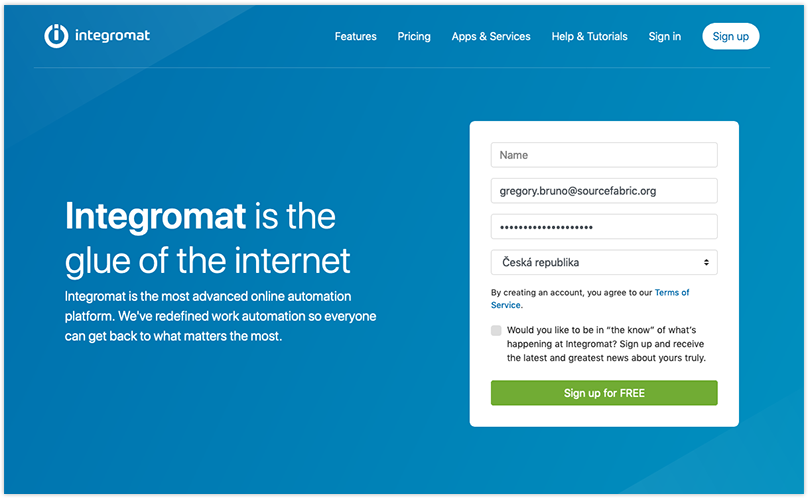
- Click the “Create a New Scenario” button in the top right corner of Integromat.com. This will bring you to a page where you can set up your first module. To do that, type “Twitter” in the search bar. Once you’ve selected Twitter, hit “Continue.”
- On the next screen you’ll see the dashboard for the scenario you’re going to create. Click on the question mark (“?”) and select, “Watch Tweets.”
- Now you need to permit your Twitter module to watch tweets using your newsroom’s Twitter account. Do this by adding a connection, naming it, and then by clicking “Authorise.”
- We want to configure Integromat to watch “Someone Else’s Tweets;” pull the dropdown menu to do that.
- Now, enter the Twitter handle, or “Screen Name,” minus the @ symbol, of the account you want to ingest into Live Blog. Select “Return Full Text of Tweets,” and then choose how many tweets you want Integromat to ingest at a time. You can choose any number you want.
- Finally, you need to tell Integromat when to start ingesting tweets. You can choose any date in the past or from now on.
Setup Part II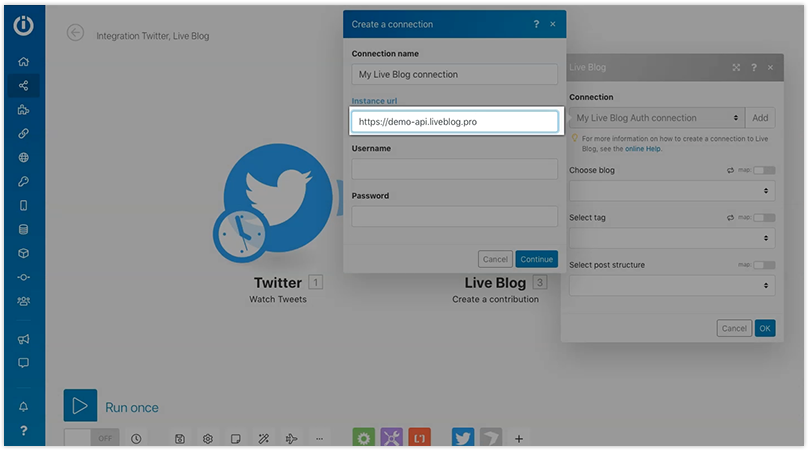
With your Twitter module established, the second step is to configure Integromat to connect this module to your Live Blog account. To do that, follow these steps:
- Click on the half-bubble to the right of the newly-created Twitter module, select the “+” button, and type “Live Blog.”
- If you don’t see Live Blog as an option, click on this link, add the scenario to your account, refresh the page, and then try again.
- Once you’ve selected Live Blog, you’ll be prompted with a window of choices; select “Create a Contribution.”
- Next, you’ll be asked to set up a connection between your Live Blog module in Integromat, and your Live Blog account. To do that, click the “Add” button, create a connection name – it can be anything – then add the URL for your blog. Importantly, you must add “-api” to make the URL work. [Example: https://demo–api.liveblog.pro]. This tells Live Blog that a third-party app is trying to connect.
- Enter your username and password.
- If your Live Blog instance has more than one blog associated with it, the next window will prompt you to choose a specific blog to connect to.
- You can ignore the “Select Tag” box, but below that you must enter a value for “Select Post Structure.” Pull that dropdown window and select “Twitter Post.” Here, you will once again need to input the “Screen Name” of the Twitter account that you are following.
- Finally, in the “Tweet ID” box, you need to provide the identification that we are getting from the blue module. Click the blue “Tweet ID” box, and the field will auto populate. You can ignore the “Autopublish” box.
- Click “OK.”
- Now, establish the intervals that Integromat will pull content from the Twitter account you’re watching. Set that by clicking the “Clock” icon.
- Once you’ve established the connection in Integromat, click “Run Once” to start feeding tweets into your Live Blog from the selected Twitter account.
- Finally, be sure to click “Save.” If you want to watch another Twitter account in your Live Blog editor window, you’ll need to create another scenario by repeating Parts I and II.
Setup Part III
Now, let’s see what all of this looks like in Live Blog.
On the left side of your Live Blog editing panel, click the “Contributions” button. Inside this pane is where all of the tweets fetched from the account or accounts that you are watching will appear. When you want to publish a tweet to your blog, simply push this “Publish” button, and it’s done. If you want to remove a tweet to keep this pane organised, click “Remove.”
Once you publish, you can see what it looks like by clicking “Live” next to “Timeline” at the top of your editing window.
And that’s it. With this integration, you’ll never again need to switch between windows or copy embed codes to share a newsmaker’s tweets with your audience. Everything you need to post quickly is now right in the editing screen of your Live Blog.
May 26, 2020
Live Blog Examples: Great Use Cases for Blogging Inspiration

Live Blog Examples: Great Use Cases for Blogging Inspiration
by Todd Jatras | May 26, 2020
Live blogs are a key editorial format used in newsrooms around the world to provide continuous, real-time coverage of important events as they happen.
Whether it’s scheduled events such as sports matches, elections, product launches and cultural events, or unpredictable occurrences such as severe weather and disasters, terror attacks and political unrest, a live blog’s curated timeline format allows news organisations to quickly break a story, then provide frequent updates after it’s been published and syndicated.
This go-to form of storytelling has seen an unprecedented surge in usage this year as the coronavirus pandemic emerged, and news sites scrambled to keep up with the rapidly evolving crisis. The advantage of using a live blog to cover such an important story is that it provides a dynamic, centralised repository where writers and editors can collaborate on quick-fire updates while effortlessly incorporating rich multimedia formats and posts from all the social media platforms. Readers also prize the format as they know exactly where to return to get the latest updates.
In this post we discuss a variety of live blogging use cases separated out by the most popular categories or story types. We’re including examples from our own customers as well as other live blog examples from around the web that best illustrate the potential of the format.
Elections and Politics
Live Blog is the perfect journalistic tool for covering elections with up-to-the-minute updates as they come in.
- See how Passauer Neue Presse used our live blogging platform to cover the spring municipal election in Bavaria;
- Norwegian online news site Nettavisen used it to report City Council meetings in Oslo, thus boosting reader engagement while increasing local government transparency.
Politics isn’t limited to elections and legislative debates, however. Court cases and judicial proceedings also lend themselves to live blogging. This live blog of orders and opinions issued by the United States Supreme Court shows how a curated timeline of official updates from the bench, interspersed with expert commentary, can provide insight into an otherwise obscure arm of government.
For more tips, see this guide to optimising elections coverage, which shows you how to use custom post types, image slideshows and advanced features for charting and live poll reporting.
Sports

Sporting events are particularly well-suited to live blogging because of the timed-play nature of most popular games, like football. Avid fans often will keep a live blog open while watching a game on television, looking to the blog repeatedly in second-screen mode throughout an event for the latest replays, statistics and play-by-play commentary from both experts and fans.
For some examples of how top news agencies as well as small media outlets are live blogging sporting events, see:
- Tagesspiegel’s Bundesliga football coverage
- Independent sports blog AthleticsAfrica uses Live Blog to report on African athletes, with an emphasis on track and field, road running and cross country.
True fans are eager for as much information as they can find on their favourite teams, and players when they’re off the field. Player transfers are an example of a sporting event other than a game that lends itself to live blogging, such as this one run by The Standard in the UK. Live blogs that include custom post types for player transfers make it even easier for fans to keep track of who is headed where, and how teams are shaping up for the season ahead.
Meanwhile, video gaming or esport events are becoming more popular, as are blogs covering them. For an example of how Live Blog was used for a global esports tournament, see dpa and Morgenpost’s team coverage of the 2018 ESLOne event in Hamburg.
Weather and Natural Disasters
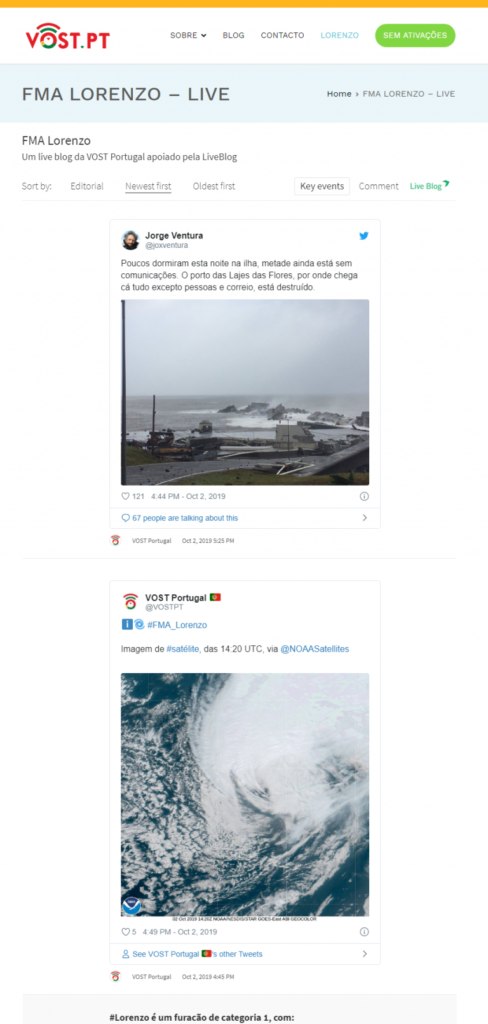
When disasters strike, providing readers with the latest, up-to-the-minute information is crucial, and can even be life-saving.
In the context of the coronavirus pandemic, this case study outlines how German-language news outlets such as Austria Presse Agentur (APA), Zeit Online and dpa have been using our live blogging software to deliver continual updates to their readers.
Other use cases from our customers include:
- the Nepali Times coverage of the 2015 Earthquake in Nepal
- how VOST.PT tracked Hurricane Lorenzo as it approached the Azores archipelago in 2019
- DPA’s coverage of the June 2019 European heat wave.
Cultural Events
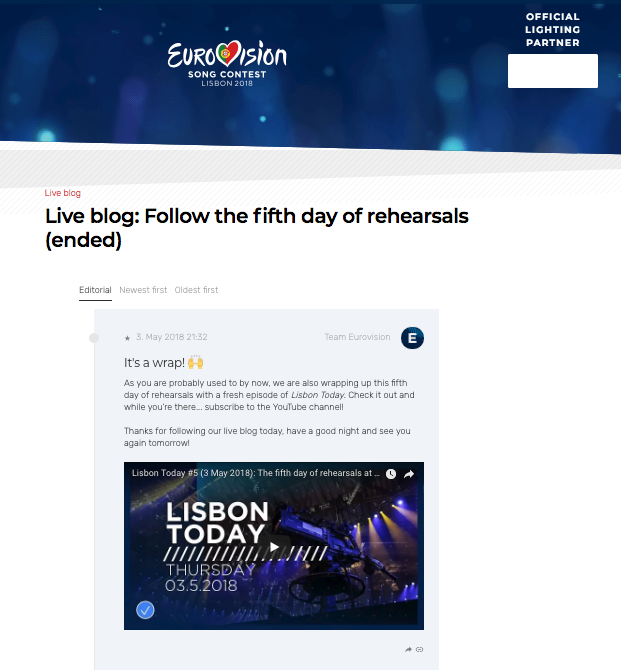
Awards ceremonies, festivals, concerts and art events are prime occasions to live blog and provide readers with a sense of being in attendance. This guide to Live Blogging a Cultural Event is a good place to start thinking about how to set your coverage apart.
Other Live Blog examples include dpa’s live blog on the 2020 Grammy music awards in Los Angeles, and Eurovision’s coverage of its 2018 Song Contest, one of the largest TV events in the world.
War and Terror Attacks
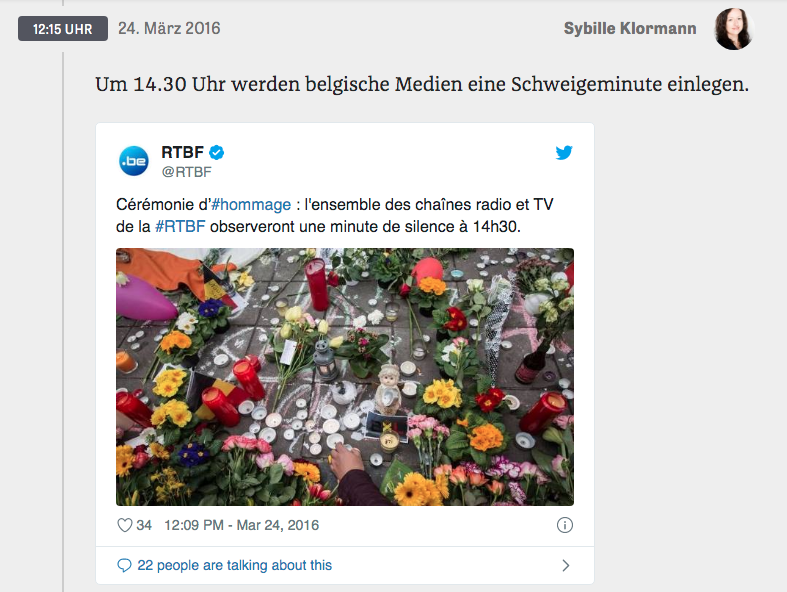
German news site Zeit Online used Live Blog for extensive coverage of the 2016 terror attack on Brussels and experimented with what they call a “slow blog” on the years-long reporting on the Battle of Mosul. We interviewed Sybille Klormann, lead editor for all live blogging projects, to learn about Zeit Online’s best practices for this dynamic form of real-time coverage.
The Environment

As climate change drives a variety of other crises, reporting on the environment has become more urgent; many news organisations are devoting significantly more time and resources to the subject.
Ambiental Jalisco, a startup network of local news sites in Mexico focused on getting citizens involved in ecological issues in cities across the country, is using our live blogging platform to bring their news and social networks together. Read our case study on Ambiental Jalisco here.
Business

Live blogging is a practical way to track earnings releases and product launches as well as the daily gyrations of international stock markets and individual business sectors.
DPA used Live Blog to report Apple’s 2019 Keynote, highlighting all of the company’s new product releases as they were being announced. Ars Technica has also live blogged Apple launch events.
Elsewhere, CNBC creates a new market-related live blog each day, frequently updating it and pulling together the top stories affecting U.S. stock markets.
Travel and Lifestyle
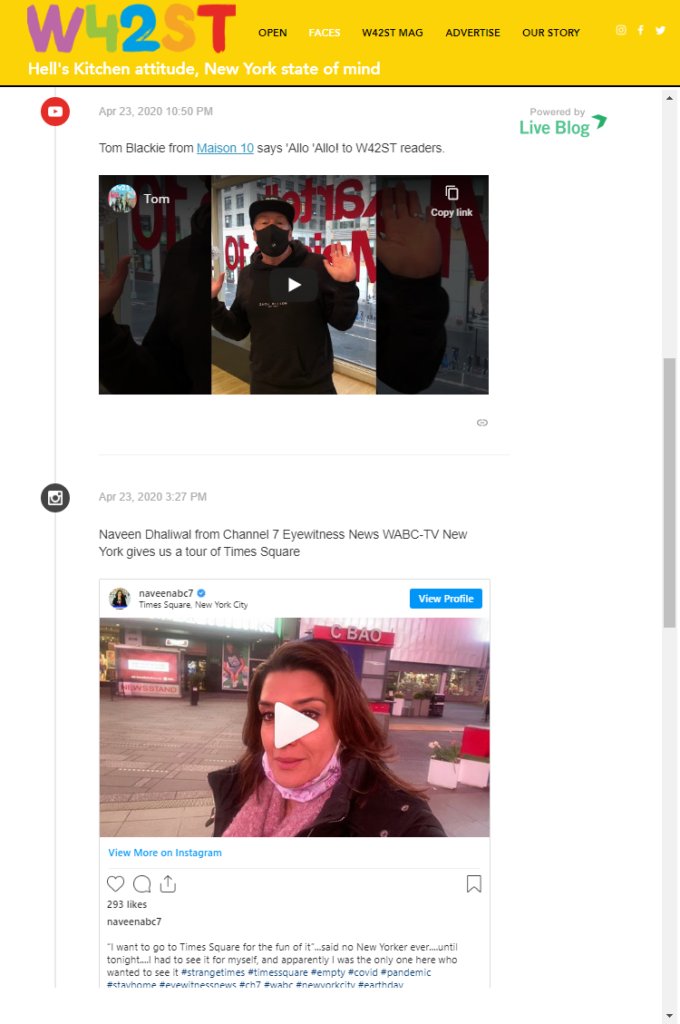
With so many travel and lifestyle blogs in the digital world, finding a way to differentiate your content and speak to an audience is key. One of our picks for creativity combined with authenticity is W42St, an independent lifestyle magazine that chronicles the people and businesses of NYC’s gritty Hell’s Kitchen neighbourhood. When the coronavirus pandemic hit, they were forced to suspend their print edition, and turned to Live Blog as a way of keeping their community connected.
Weird News, Photo of the Day and Other Offbeat Stories
Finally, the live blog format offers a way for publishers to package content and earn revenue on new products; especially using recurring, daily news features so that customer news organisations can receive it via syndication and readers can easily find it with content tags.
DPA’s Top Photo of the Day is a good example of this. Also, their Weird News & Other Offbeat Stories is currently embedded in around two dozen customer websites, including Mitteldeutsche Zeitung and Radio Essen.
Elsewhere, Reuters has a blog called Oddly Enough that collects and syndicates daily offbeat and humourous stories to their clients.
If you are not yet a Live Blog user and you’re looking for live blogging software to cover real-time news, you can try Live Blog for free here, no strings attached.
May 5, 2020
Case Study: How an Indy NYC Print Magazine is Using Live Blog to Build a Community and Connect Readers

CASE STUDY
W42St: How an Indy NYC Print Magazine is Using Live Blog to Build a Community and Connect Readers
by Todd Jatras | May 5, 2020
When the coronavirus pandemic abruptly forced New York City into lockdown mode in March 2020, businesses across the spectrum had to radically reduce operations and shift strategies in a bid for survival.
Live blogging turned out to be part of the solution for one independent publisher based in a historically gritty part of Manhattan. W42ST is a monthly independent lifestyle magazine that prides itself on the “fierce, pioneering, no-bullshit attitude” characteristic of the Hell’s Kitchen neighbourhood (the area west of Times Square-42nd Street) it covers. Founded five years ago by British transplant Phil O’Brien, a former press photographer and entrepreneur, W42ST had built up a healthy print run of 30,000 and established itself as a community-building force through a combination of social media outreach and live events.
The Challenge
By Friday the 13th of March, with most of W42ST’s advertising from area businesses such as Broadway theatres, restaurants, coffee shops, gyms, bars and liquor stores having suddenly evaporated, O’Brien had to make the difficult decision to put the brakes on the print edition just as the much-anticipated annual Best Of issue was getting ready to go to press.
For a magazine whose mission is to “connect people and help them live their best New York life, in real life” the issue was not so much being able to publish in print as being able to serve readers during a time of social isolation.
O’Brien didn’t hesitate to take the digital leap
The Solution
With most businesses in the community reeling and readers stuck at home, O’Brien realised that shifting to a daily, digital publishing rhythm was the best way to keep readers connected to each other as well as informed about developments that seemed to be changing by the hour.
Along with a new daily newsletter, Live Blog is the main element to this change of digital publishing strategy. W42ST’s new FACES section is a live blog featuring short videos sent in by readers and local business owners reporting on their lives under quarantine and the latest developments in the neighbourhood. Beyond a means of publishing survival, the FACES live blog has been a chance to expand coverage while strengthening the bonds within an already well-established community.

W42ST’s Live Blog features daily videos from neighbourhood readers and business owners.
The Results
W42ST’s FACES is an exemplar of how live blogging can be used to bring together and connect a community, even during normal times. O’Brien loves the versatility of Live Blog, especially its ability to easily ingest content from all the different social media platforms, saying: “Live Blog is great because it’s so easy to upload a variety of YouTube and Instagram videos–and they play flawlessly within the blog”.
The dozens of videos featured so far on FACES form a fascinating, intimate and constantly-changing portrait of a strong community coming together to cope with an unprecedented situation. They are equally informative and entertaining, and full of tips on everything from local kitchens doing deliveries to an artist giving away the masks they’ve made in exchange for fabric donations. Local business owners, even front-line medical workers, make appearances to give updates, while residents drop in to share the joys and frustrations of their day, or sing a song, show off their pets, or recite poetry.
Looking ahead to life after the lockdown, O’Brien hopes to expand W42ST’s blogging activity beyond FACES, and has applied for grants from Google and Facebook’s local news initiatives with the hope of hiring a dedicated blog editor. About Live Blog, O’Brien adds, “You’ve built a great product”.

